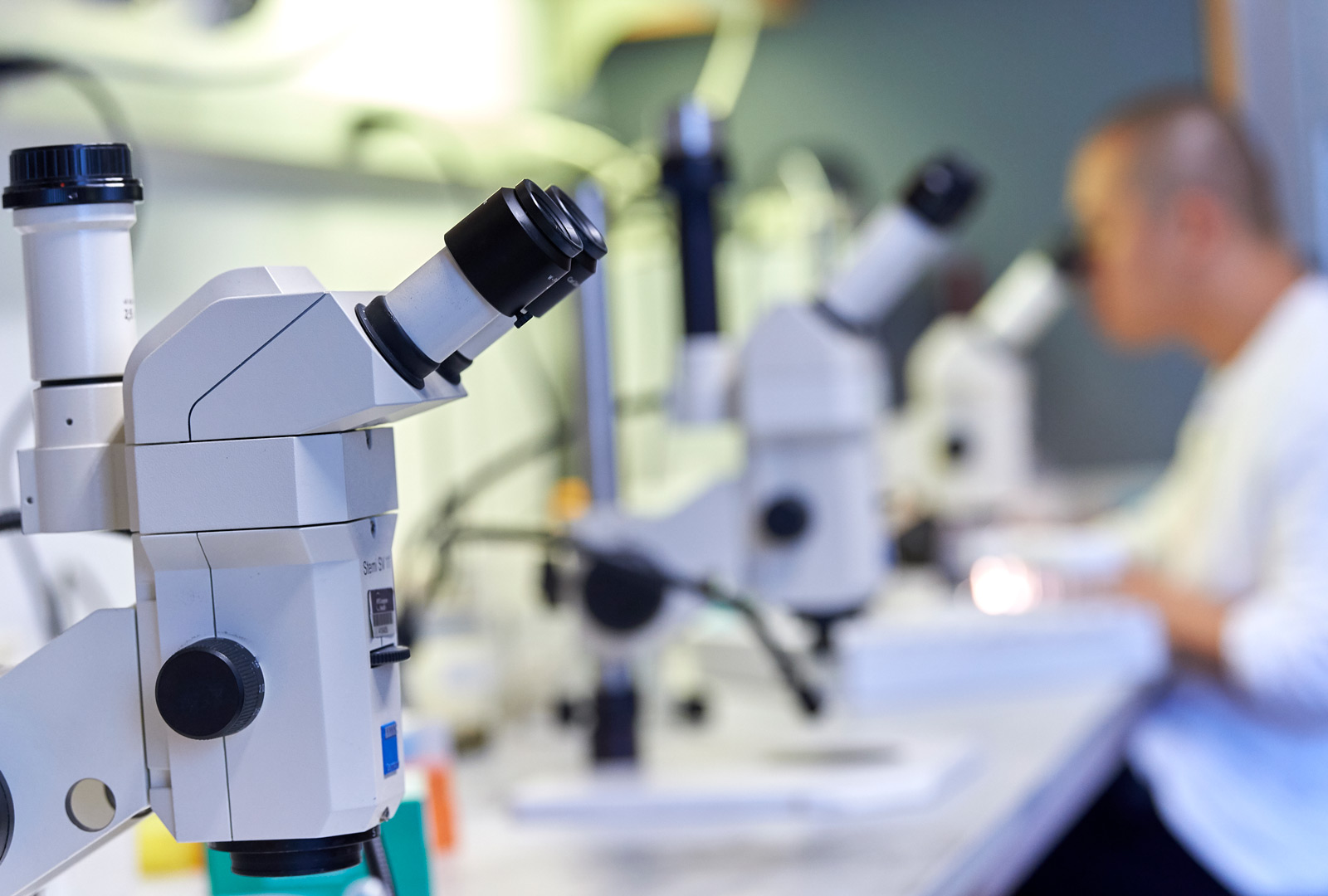
Center for Human Genetics & Genomics Research
Human genetics research covers a wide range of biomedicine, from the molecular sciences to population health and biomedical ethics. Few sciences are as expansive and interdisciplinary, or have such direct implications for human health. It is this diverse range of areas and the direct connections to our lives that make human genetics exciting to a wide audience.
Investigators in NYU Langone’s Center for Human Genetics and Genomics have the expertise to develop new technologies to capitalize on these interdisciplinary opportunities and advance our fundamental understanding of genetic disorders.
The Significance of Human Genetics Research
Historically, human genetics has been a largely descriptive science focused on rare disorders. Although that focus provided the rationale for the Human Genome Project and led to the human gene map, its broader impact on medicine has been modest. Sequencing of the human genome, however, is allowing for the rapid elucidation of the molecular basis of genetic disorders, thereby transforming the field.
Human genetics is also increasingly used to study the molecular basis of common chronic disorders because gene identification can expose disease pathophysiology and provide rational targets for new therapies. This research has revealed many new areas of human biology, uncovering the vast genetic heterogeneity of human diseases and the individuality of illnesses.

In our research, we emphasize four areas unique to human genetics: genome biology, disease gene discovery, genomic disease biology, and modeling and disease risk prediction.
These research areas have a common theme. We are using the genomic tools, technologies, and databases of human genetics, together with studies of clinical populations, to mechanistically understand how interactions of many genes across the genome lead to a specific pathophysiology.
Genome Biology
Genomic variation between individuals affects both genetic and epigenetic functions. Consequently, basic genetic processes such as recombination and mutation are also variable. This variation, described as “genetic background,” is poorly understood and characterized even though it affects health and disease in major ways.
In our genome biology research programs, we work to identify the mechanisms leading to genetic background effects, which is intrinsic to understanding how disease susceptibility varies.
We particularly focus on characterizing human genomes at the functional level. We aim to create a program to construct cell type–specific gene regulatory networks (GRNs) that can integrate genomic function with gene transcription and translation, as well as their feedback, uniting genetic effects across DNA, RNA, and proteins.
Each functional genome can be characterized by a set of modular GRNs that provide the logic of how biological functions in cells emerge (the “wiring diagram” of the cell). We aim to characterize modular GRNs in both mouse and human cells to understand how function is delineated, conserved, and diversified beyond the primary sequence. This is crucial because the basic units of pathophysiology are not individual genes but functional regulatory networks.
Disease Gene Discovery
We have much more to learn about the causes of heritable disorders: no more than 50 percent of rare disorders can currently be identified through single gene mutations in a DNA sequence. Possible reasons for this include the presence of noncoding mutations that are difficult to identify, as well as interactions between variants at multiple genes. Solving this puzzle will enable an understanding of rare disease etiology and lead to a more accurate specification of genetic risks to family members of affected patients.
Building functional models of these disorders requires that we use new approaches and technologies to identify these multiple causal factors and reveal previously unknown disease biology and mechanisms. Our GRN project complements this effort because GRNs lead to suggestions of novel genes as disease candidates.
Despite progress in understanding rare congenital disorders, the major unsolved problem in human genetics is elucidating the genetic basis of common chronic disorders. Here, despite progress in mapping multiple genetic factors, we are only partly successful because very little of the risk related to any single disorder has been explained, with some rare exceptions.

Our research programs tackle this major need in two ways. First, for existing gene discoveries, we will use the GRN approach to identify new genes, variants, and mechanisms. As shown by work done in the laboratory of Aravinda Chakravarti, PhD, complex disorders are complex by virtue of having a diverse set of genes located across the human genome but united through common pathways of biological function.
Second, existing genetic studies have focused on only one disease, or clinical trait, at a time, even though genes have diverse effects in different tissues (they are pleiotropic). In other words, a genetic variant can have effects, or genetic predispositions, for more than one disorder. One solution to this dilemma is to use electronic health records that can provide a complete picture of an individual’s health and disease status across time. If whole-genome sequencing is performed on these same individuals, then machine learning and novel statistical methods can be used to efficiently identify the pleiotropic effects of sequence variants and their effects across time irrespective of which disease they affect.
Finally, information on the course and duration of an individual’s disease, important for identifying biological subgroups of patients, is key for translational research and clinical purposes. Using the patient repository of electronic health records at NYU Langone, we can make major headway into solving the genetics of common disorders and understanding disease pathophysiology by adding sequence-level genetic information to this collection.
Genomic Disease Biology
Our program in genomic disease biology is geared toward providing a mechanistic human systems biology for complex disorders that complements the ongoing work of creating a human cell atlas.
In these studies, we aim to deconstruct regulatory networks on a cell type–specific basis, using single-cell technologies and computational biology to reach an understanding of human disease in unprecedented detail.
We will also pursue the broader question of identifying key factors, such as inflammation, that are components of many human diseases. Does genetic individuality necessarily imply phenotypic individuality? Or is there functional convergence on a smaller set of phenotypic pathways despite the variation in hundreds of genes? Answering these questions is important to identifying the causal factors in human disease and determining how many such distinct pathways exist.
A common assumption in biomedicine is that genetic effects are fixed and change slowly over time. This view does not take into account noncoding elements and epigenetic effects, which vary over time and in concert with other factors. We aim to study the magnitude of this effect, which we believe is substantial.
Even inherited fixed variation can change rapidly through demographic changes at the population level. These changes alter our collective genomes at a rate that is orders of magnitude greater than what occurs through evolution, changes that now occur at the same scale in mere decades. All the phenotypic variation we see in humans today is the result of both biological and demographic change, a science we can develop based on population genetics.
Understanding these genomic changes and their rates of occurrence is critical because they will severely affect the distribution and prevalence of human disease across age, sex, and communities in the next few decades. This predictive aspect of human genetics and genomics is important for predicting future population-level disease rates and patterns.
Modeling and Predicting Disease Risks
We are in the very early stages of predicting disease risks for individuals based on their genome sequences. The goals of the new science of human genetics are not only to predict disease in individuals but to be able to personalize treatment.
A major goal of our research is to engage in a new type of genetic epidemiology that allows such predictions. Current approaches to this problem are empirical or ad hoc. We aim to develop methods of prediction that are based on the genome sequence of individuals depending on genome mechanisms and genome biology.
Significantly, these studies will require us to build new cellular and mouse models of complex disorders using the synthetic biology approaches pioneered by Jef D. Boeke, PhD, and his group at the Institute for Systems Genetics. These approaches are not actively pursued elsewhere. We believe that the underlying science provides a basis for a new collaborative approach to human genetics and the understanding of genetic disorders.
Disclaimer: NYU Langone’s programs do not include preferences, quotas, or set asides, or otherwise exclude anyone based on race, sex, or other protected categories.
